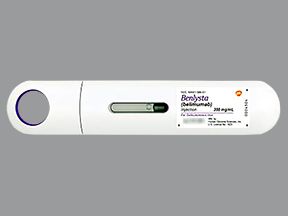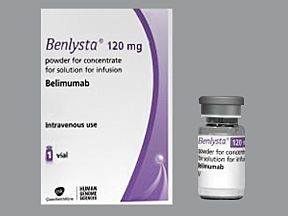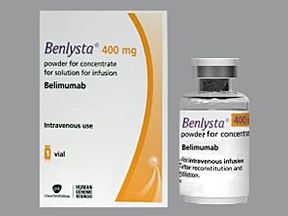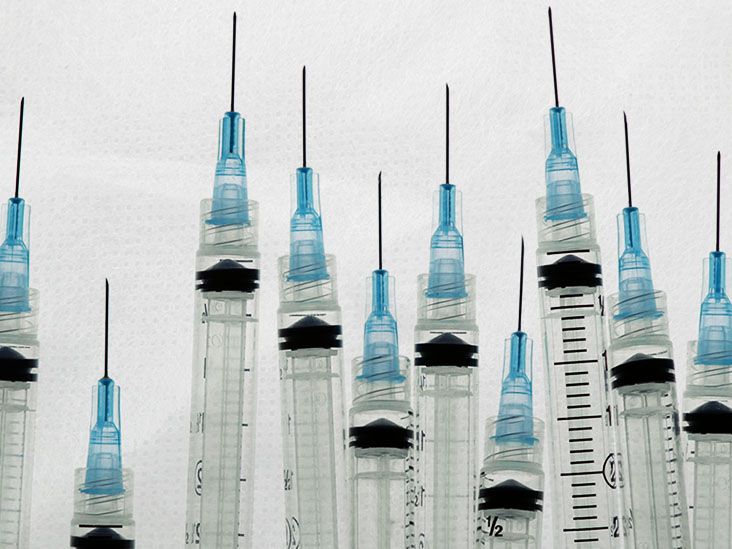Benlysta (belimumab) is a brand-name drug prescribed for lupus and kidney disease complications caused by lupus. It’s given by self-injection or intravenous (IV) infusion. The dosage can vary depending on the condition being treated.
Benlysta is approved by the Food and Drug Administration (FDA) to treat:
- systemic lupus erythematosus (SLE), the most common type of lupus
- lupus nephritis, a complication of SLE that affects the kidneys
Benlysta is a biologic and belongs to a drug class called monoclonal antibodies. Specifically, it’s a type of monoclonal antibody called a B-lymphocyte stimulator-specific inhibitor.
Benlysta isn’t available in a biosimilar version.
Keep reading for specific information about the dosage of Benlysta, including its strengths and how the drug is given. To learn more, see this Benlysta overview article.
Note: This article describes typical dosages for Benlysta provided by the drug’s manufacturer. However, your doctor will prescribe the Benlysta dosage that’s right for you.
Read on to learn about Benlysta’s dosages.
Benlysta forms
Benlysta comes in two forms:
- Powder that’s made into a liquid solution for IV infusion. This is given by your doctor or another health professional at your doctor’s office, infusion center, or a hospital.
- Liquid solution in single-dose prefilled syringes and auto-injectors for subcutaneous injection. You’ll self-inject this form of Benlysta.
For details on how you’ll receive these forms of Benlysta, see the “How Benlysta is given” section on this page.
Benlysta strengths
Benlysta comes in the following strengths:
- Powder that’s made into a liquid solution for IV infusion:
- 120 milligrams (mg)
- 400 mg
- Liquid solution in single-dose prefilled syringes and auto-injectors for subcutaneous injection:
- 200 mg per milliliter (mg/mL)
Typical dosages
Benlysta’s typical dosages depend on the drug form your doctor prescribes and the condition being treated. Your doctor may also prescribe a higher dosage at the start of treatment. This is a loading dose. It helps increase the amount of the drug in your body so the medication starts working faster.
The following information describes dosages that are commonly prescribed or recommended. However, be sure to take the dosage your doctor prescribes for you. Your doctor will determine the best dosage to fit your needs.
Dosage for systemic lupus erythematosus (SLE)
To treat SLE, your doctor may prescribe Benlysta as an IV infusion or subcutaneous injection.
The following table outlines Benlysta’s dosage in adults for both the IV infusion and injection. Doses are provided in milligrams (mg) or milligrams of drug per kilogram of body weight (mg/kg). One kg is approximately 2.2 pounds (lb).
| Condition | How Benlysta is given | Loading dosage | Maintenance dosage |
|---|---|---|---|
| SLE | IV infusion | 10 mg/kg once every 2 weeks for 3 doses | 10 mg/kg once every 4 weeks |
| SLE | injection under the skin | — | 200 mg once per week |
Your doctor will use a dosing calculator to determine your dosage for the infusion. For example, if you weigh 68 kg (about 150 lb, you’ll receive 680 mg of Benlysta with each infusion.
Note: If your prescription changes from Benlysta IV infusions to subcutaneous injections, your doctor will adjust your dosing schedule. You’ll receive your first 200 mg injection between 1 to 4 weeks after your last IV infusion. Your doctor will determine the timing of your first injection.
Dosage for lupus nephritis (kidney disease due to lupus)
To treat lupus nephritis, your doctor may prescribe Benlysta as an IV infusion or subcutaneous injection.
The following table outlines Benlysta’s dosage in adults for both the IV infusion and injection. Doses are provided in mg or mg/kg.
| Condition | How Benlysta is given | Loading dosage | Maintenance dosage |
|---|---|---|---|
| lupus nephritis | IV infusion | 10 mg/kg once every 2 weeks for 3 doses | 10 mg/kg once every 4 weeks |
| lupus nephritis | injection under the skin | 400 mg once per week for 4 doses | 200 mg once per week |
Your doctor will use a dosing calculator to determine your dosage for the infusion. For example, if you weigh 68 kg (about 150 lb), you’ll receive 680 mg of Benlysta with each infusion.
Note: If your prescription changes from Benlysta IV infusions to subcutaneous injections, your doctor will adjust your dosing schedule. You will need to complete the first two IV infusions, then you’ll receive your first 200 mg injection between 1 to 2 weeks after your last IV infusion. Your doctor will determine the timing of your first injection.
Children’s dosage
Benlysta is used to treat SLE and lupus nephritis in children ages 5 years and older.
For IV infusions, a child’s dosage is the same as for adults. For the auto-injector pen, the dosage depends on the child’s body weight. (The prefilled syringe is not approved for use in children.)
The table below outlines Benlysta’s dosage in children. Doses are provided in mg or mg/kg.
| Condition | How Benlysta is given | Loading dosage | Maintenance dosage |
|---|---|---|---|
| SLE | IV infusion | 10 mg/kg once every 2 weeks for 3 doses | 10 mg/kg once every 4 weeks |
| SLE | injection under the skin | — | • 15 kg to less than 40 kg: 200 mg once every 2 weeks • 40 kg or more: 200 mg once weekly |
| lupus nephritis | IV infusion | 10 mg/kg once every 2 weeks for 3 doses | 10 mg/kg once every 4 weeks |
Your child’s doctor will calculate your child’s dosage based on their body weight. For example, if your child weighs 25 kg (about 55 lb), they’ll receive 250 mg with each infusion.
Long-term treatment
Benlysta is meant to be a long-term treatment. If you and your doctor determine that Benlysta is safe and effective for you, you’ll likely have long-term treatment.
If you have any questions about your Benlysta dosage, talk with your doctor.
The Benlysta dosage your doctor prescribes will depend on several factors. These include:
- the type and severity of the condition you’re taking Benlysta to treat
- the form of Benlysta you’re prescribed
- your body weight, which may change over time
Other medical conditions you have can also affect your Benlysta dosage.
Benlysta is given by IV infusion or subcutaneous injection.
Your doctor or another healthcare professional will give you the IV infusion of Benlysta. First, they’ll mix the powder form of Benlysta with a liquid to make a solution. Then, they’ll prepare the liquid solution for infusion. You’ll likely go to your doctor’s office, infusion center, or a hospital to receive your infusion. The infusion takes about 1 hour.
With a subcutaneous injection, you’ll inject the medication under your skin. You’ll use the prefilled syringe or auto-injector to give yourself Benlysta. Your doctor will give you your first dose. Then, they’ll show you (or your caregiver) how to do it.
Note: For detailed instructions about using Benlysta prefilled syringes and auto-injectors, see this medication guide.
To give yourself an injection at home, your doctor will advise you to:
- Take the syringe or auto-injector out of the refrigerator about 30 minutes before you take your dose. This allows the drug to come to room temperature (68°F to 77°F [20°C to 25°C]).
- Inspect the syringe or auto-injector to make sure the solution is clear and yellow. Do not use it if the solution is cloudy or has particles floating in it.
- Inject the medication into your thigh or abdomen, avoiding the belly button area.
- Choose a different site for each injection, such as another area of your thigh.
- Avoid skin that’s tender, bruised, hard, or discolored.
Talk with your doctor if you have questions about giving yourself Benlysta.
ACCESSIBLE DRUG LABELS AND CONTAINERSSome pharmacies offer labels with large print, braille, or a code you scan with a smartphone to convert text to speech. If your local pharmacy doesn’t have these options, your doctor or pharmacist might be able to recommend a pharmacy that does.
If you miss your Benlysta IV infusion appointment, call your doctor’s office as soon as possible. They can reschedule your appointment. Your doctor will make any necessary adjustments to your schedule.
If you miss a subcutaneous injection, give the injection as soon as you remember. Then, you can either resume your regular schedule or start a new schedule 1 week after giving the missed dose. If you’re unsure about when to give your next dose of Benlysta, talk with your doctor or pharmacist.
To help make sure that you don’t miss a dose, try using a medication reminder. This can include setting an alarm or using a timer. You could also download a reminder app on your phone.
If you self-inject Benlysta, it’s important that you do not give yourself more Benlysta than your doctor prescribes. For some medications, taking more than the recommended amount may lead to side effects or overdose. (Learn more about Benlysta’s side effects.)
If you give more than the recommended amount of Benlysta
Call your doctor right away if you believe you’ve given yourself too much Benlysta. Another option is to call America’s Poison Centers at 800-222-1222 or use its online tool. If you have severe symptoms, immediately call 911 or your local emergency number or go to the nearest emergency room.
The dosages in this article are typical dosages provided by the drug’s manufacturer. If your doctor recommends Benlysta for you, they’ll prescribe the dosage that’s right for you. If you self-inject Benlysta, always follow the dosage that your doctor prescribes.
As with any drug, do not change your dosage of Benlysta without your doctor’s recommendation. If you have questions about the dosage of Benlysta that’s best for you, talk with your doctor.
Besides learning about dosage, you may want other information about Benlysta. These additional articles might be helpful:
- Drug comparison: Find out how Benlysta compares with Plaquenil and CellCept.
- Side effects: Learn more about the possible side effects of Benlysta.
- Details about your condition: To learn more about your condition, see our list of lupus and kidney disease articles.
Disclaimer: Medical News Today has made every effort to make certain that all information is factually correct, comprehensive, and up to date. However, this article should not be used as a substitute for the knowledge and expertise of a licensed healthcare professional. You should always consult your doctor or another healthcare professional before taking any medication. The drug information contained herein is subject to change and is not intended to cover all possible uses, directions, precautions, warnings, drug interactions, allergic reactions, or adverse effects. The absence of warnings or other information for a given drug does not indicate that the drug or drug combination is safe, effective, or appropriate for all patients or all specific uses.




